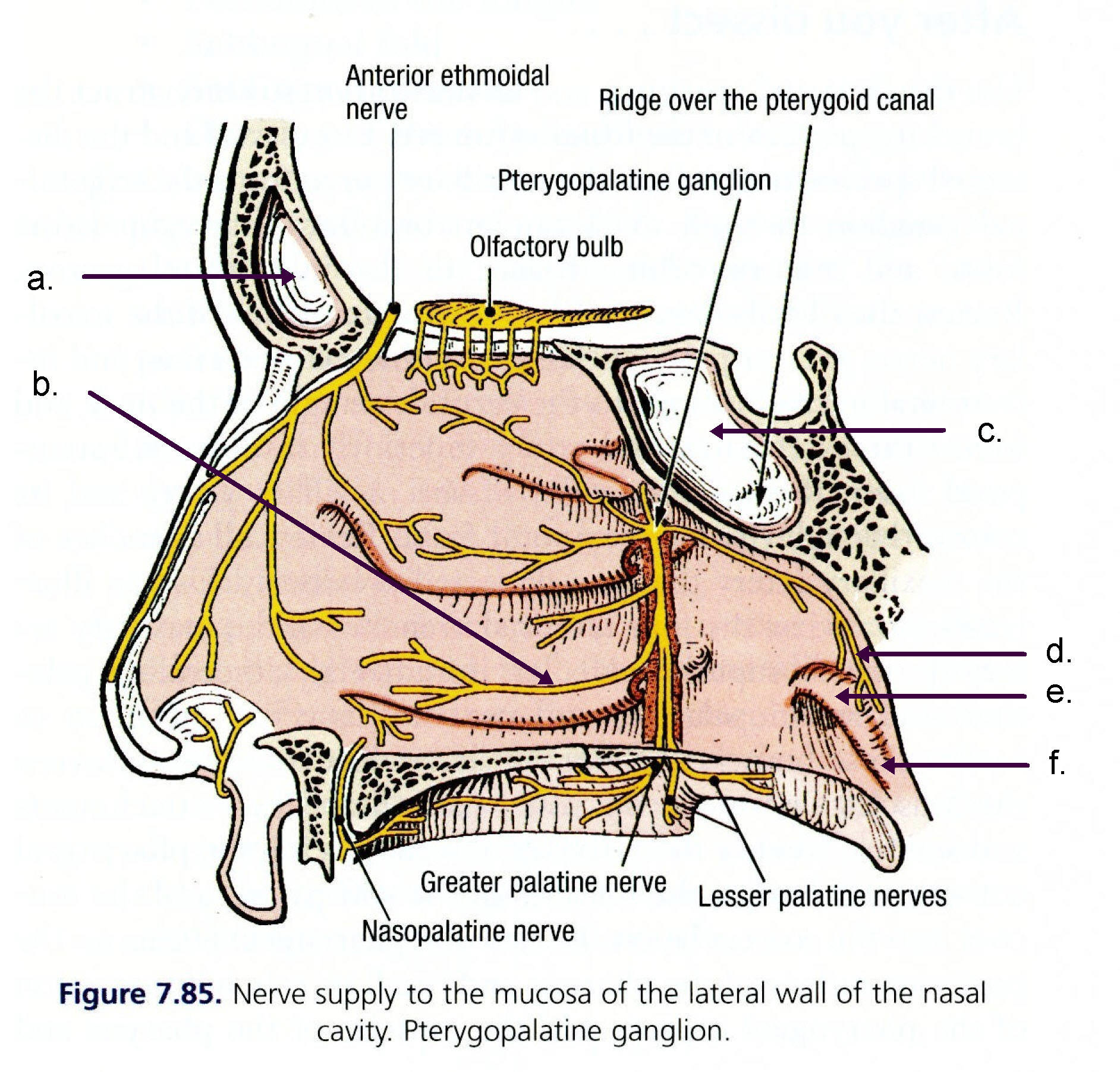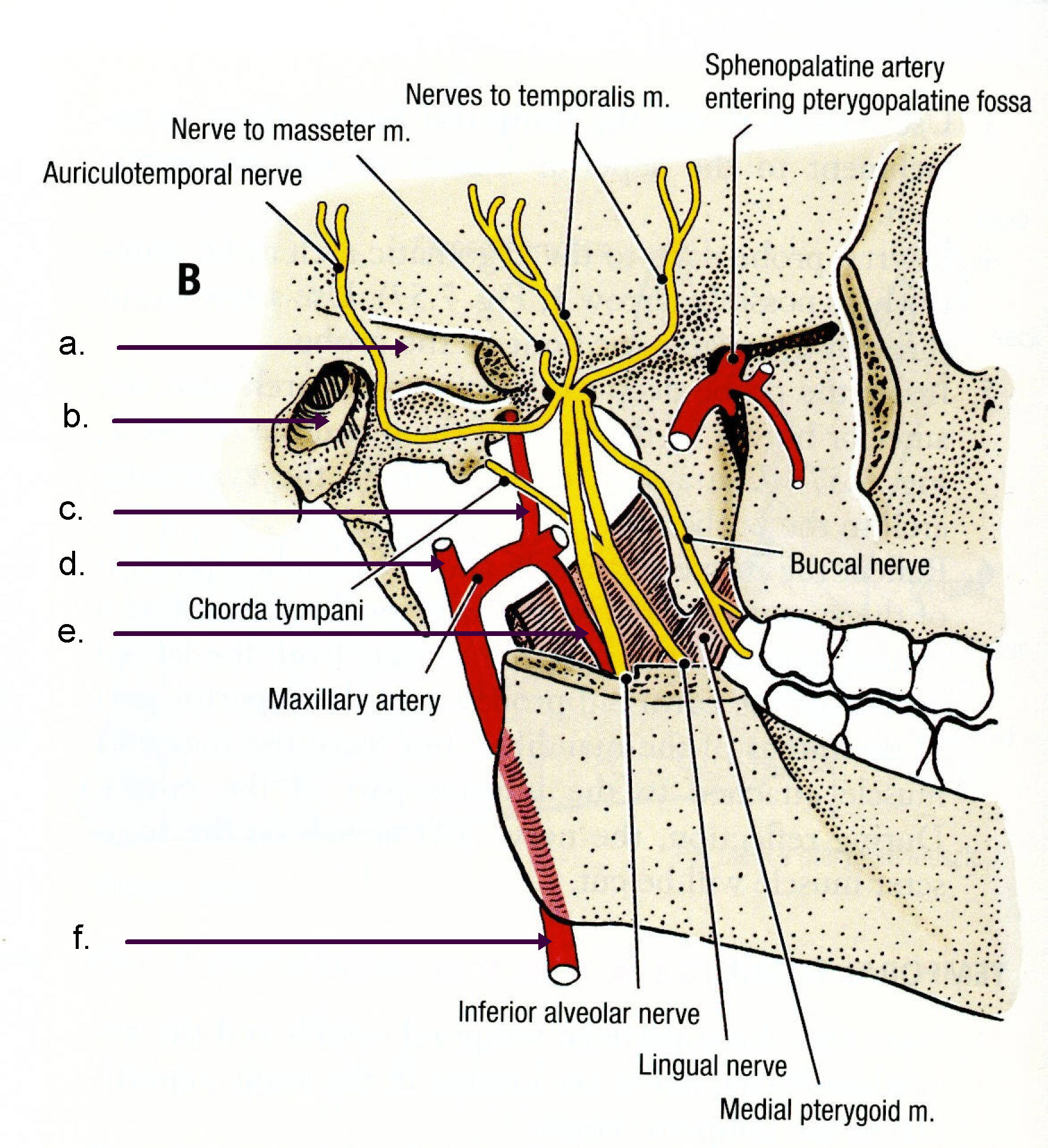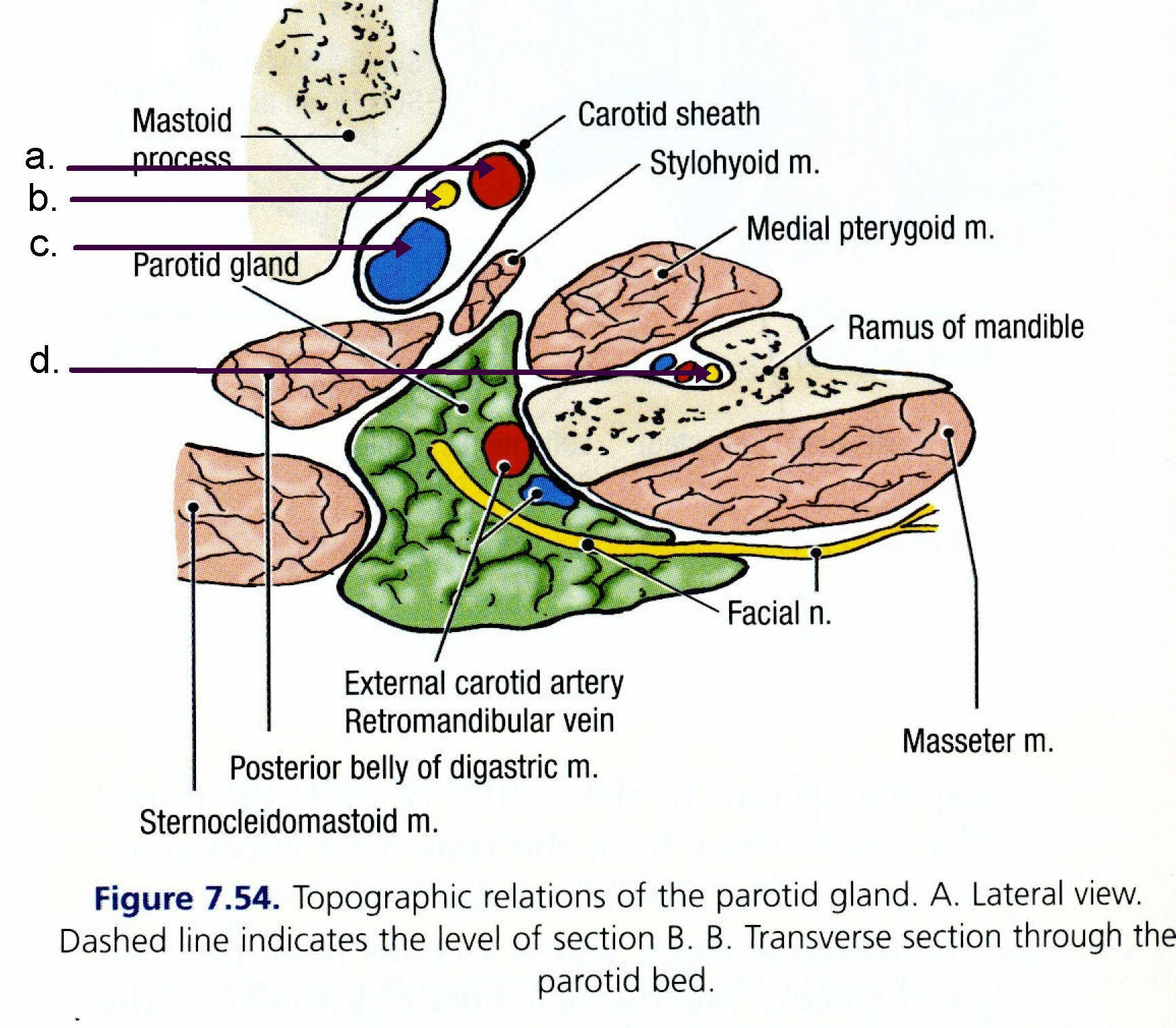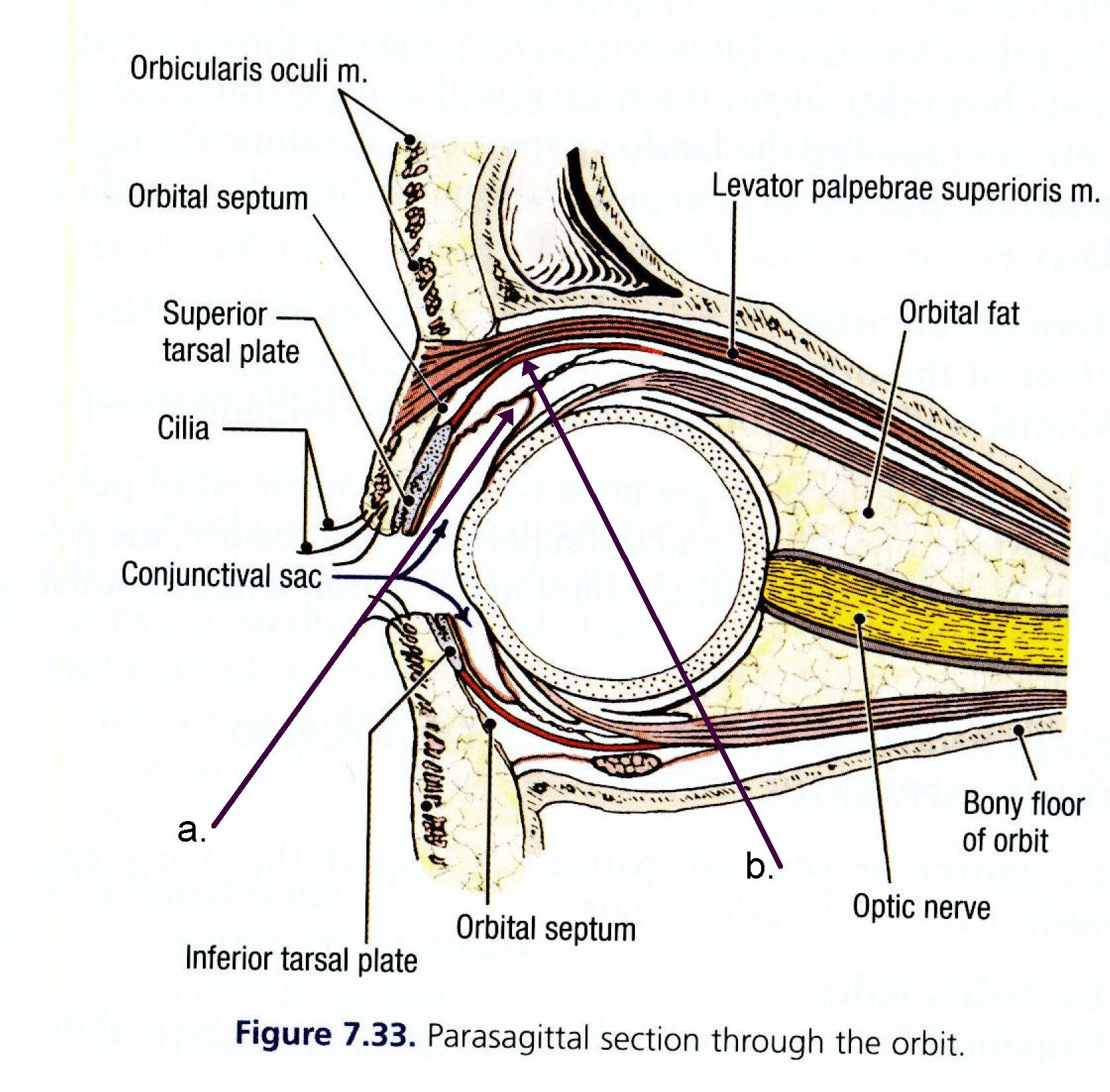
EXAM NUMBER_________________
STRUCTURAL BASIS OF MEDICAL PRACTICE
EXAMINATION 7
PART l. Answer in the space provided. (9 pts)
1. Identify the structures. (3 pts)
_Frontal Sinus
_Lateral Posterior Inferior Nasal Nerve
_Sphenoid Sinus
_Pharyngeal Nerve
_Torus Tubarius
_Salpingopharyngeal Fold

2. Identify the structures. (3 pts)
_Temporal Process Zygomatic Arch
_External Auditory Canal
_Middle Meningeal Artery
_Superficial Temporal Artery
_Inferior Alveolar Artery
_External Carotid Artery

3. Identify the structures. (2 pts)
_Internal Carotid Artery
_Vagus Nerve
_Internal Jugular Vein
_Inferior Alveolar Nerve

4. Identify the structure. (1 pts)
_Superior Conjunctival Fornix
_Superior Tarsal Muscle (Mueller's Muscle)

Part II. Circle the correct answer. All, none, or some may apply. (35 pts)
With respect to the development of the nervous system:
TRUE - The central nervous system (CNS) originates in the ectoderm.
TRUE - The neural plate appears at the middle of the third week.
The rhombencephalon is divided into the mylencephalon, mesencephalon, and prosencephalon.
The cranial end of the neural tube closes at day 45.
TRUE - The spinal cord is characterized by the basal plate containing the motor neurons, the alar plate for the sensory neurons, and a floor plate and a roof plate.
The telencephalon consists of two lateral outpocketings, the cerebellar hemispheres, and a median portion, the adenohypophysis.
TRUE - Sensory ganglia for both the cranial and spinal nerves are derived from the neural crest.
TRUE - In the third month of development the spinal cord extends the entire length of the embryo.
In regard to head and neck development:
FALSE/TRUE - The pharyngeal (branchial) arches initially consist of bars of ectodermal tissue.
TRUE - The first pharyngeal arch consists of the maxillary process and the mandibular process.
Muscles of the third pharyngeal arch such as the stapedius and stylohyoid are innervated by the nerve of the third arch, the glossopharyngeal nerve.
TRUE/FALSE - Pharyngeal clefts give rise to only one structure, the external auditory meatus.
TRUE - The paired maxillary and mandibular prominences and the frontonasal prominence are the first prominences of the facial region.
The thyroid gland appears as a mesodermal proliferation in the floor of the pharynx.
The tongue appears in embryos of approximately 8 weeks in the form of two lateral lingual swellings and one medial swelling that orignate from the second pharyngeal arch.
TRUE - Fusion of the palatal shelves, which for the maxillary prominences, creates the hard (secondary) and soft palate.
With regard to the Exterior of Skull, Scalp, and Face:
TRUE - The “danger area” of the scalp is a potential space located between the epicranial aponeurosis and the periosteum of the calvarium
The infraorbital nerve provides SVE innervation to the levator labii superioris muscle.
The facial vein and artery cross the lateral aspect of the body of the mandible with the facial vein anterior to the facial artery.
The mental nerve is a continuation of the buccal nerve.
TRUE - The scaphoid fossa is a site of origin for the tensor veli palatini muscle
False/True - The styloid process is a site of attachment for three muscles and one ligament.
4. With regard to the Interior of Skull, Meninges, and Dural Sinuses:
The groove for the anterior branch of the middle meningeal artery is on the inner surface of the occipital bone
The groove for the greater superficial petrosal nerve is posterior to the groove for the superior petrosal sinus.
TRUE - The groove for the lesser superficial petrosal nerve is anterior to the groove for the greater superficial petrosal nerve.
The inferior petrosal sinus, in part, forms the straight sinus.
TRUE - The inferior petrosal sinus communicates with the basilar venous plexus which, in turn, drains into the internal vertebral venous plexus.
The occipital sinus drains into the posterior external vertebral venous plexus.
5. With regard to the Cranial Fossa:
TRUE - The clivus is part of the occipital bone within the posterior cranial fossa.
TRUE - The sella turcica provides a boundary between the hypophyseal fossa and the sphenoid sinus.
The foramen cecum transmits an emissary vein between the posterior ethmoidal air cells and the superior sagittal sinus.
The crista galli provides a site of attachment for the tentorium cerebelli.
The internal carotid artery passes lateral to the anterior clinoid process
TRUE - The superior orbital fissure, foramen rotundum, and foramen ovale are features of the sphenoid bone.
6. With regard to the Orbit:
The ciliary ganglion is located medial to the optic nerve and lateral to the medial rectus.
TRUE - The inferior division of the oculomotor nerve provides preganglionic GVE fibers to the ciliary ganglion.
TRUE - The anterior ethmoidal artery leaves the medial wall of the orbit, crosses the anterior ethmoidal air cells, and then enters the anterior cranial fossa.
The inferior oblique muscle receives GSE innervation from the trochlear nerve.
7. With regard to the Cervical Fascia, Posterior Triangle, and Anterior Triangle:
The retropharyngeal space is located between the prevertebral fascia and the alar layer of prevertebral fascia.
TRUE - The inferior limit of the pretracheal fascia is at the posterior mediastinum.
TRUE - The axillary sheath is continuous with the prevertebral fascia.
TRUE - The phrenic nerve is located within the prevertebral fascia
The suprascapular nerve passes through the middle scalene muscle
The superior root of the ansa cervicalis is, on dissection, a branch off the hypoglossal nerve but it is, in fact, derived from the brachial plexus.
8. With regard to the Parotid Region and the Infratemporal Fossa:
The superior joint cavity of the temporomandibular joint provides hinge movement whereas the inferior cavity provides sliding movement
The deep temporal nerve splits around the middle meningeal artery
The sphenomandibular ligament attaches to the lingula of the mandible and to the hamulus of the lateral pterygoid plate.
TRUE - The chorda tympani nerve merges onto the lingual nerve and provides SVA fibers to the anterior 2/3 of the tongue and GVE fibers to the submandibular ganglion.
TRUE - The otic ganglion receives preganglionic fibers by way of the lesser superficial petrosal nerve.
TRUE - The inferior orbital fissure transmits the infraorbital artery into the orbit.
9. With regard to the Craniovertebral Joints:
TRUE - The alar ligaments connect the dens to the occipital bone and limit rotation at the atlantoaxial joint.
The cruciate ligament is a continuation of the posterior longitudinal ligament.
With regard to the Pharynx:
The superior constrictor muscle defines the posterior wall of the oropharynx.
TRUE - Touching the oropharynx to evoke the gag reflex is a test of the GVA component of the glossopharyngeal nerve.
TRUE - The cricopharyngeus muscle relaxes during swallowing.
TRUE - The nasopharynx receives GSA innervation from the pharyngeal nerve branch of the maxillary nerve.
With regard to the Larynx
The posterior cricoarytenoideus muscle is the primary adductor of the true vocal fold.
TRUE - The external laryngeal nerve provides SVE innervation to the cricothyroideus muscle.
The aryepiglottic fold is at the superior boundary of the triangular (conus elasticus) membrane.
The false vocal cord is inferior to the ventricle of the larynx
With regard to the Temporal Bone
The mastoid air cells are adjacent to the occipital sinus.
TRUE - The mastoid air cells communicate with the middle ear by way of the aditus.
The cochlea, because of its soft shell, is especially vulnerable to fracture.
The arcuate eminence reflects the underlying lateral semicircular canal.
With regard to the Pterygopalatine Fossa
TRUE - The pterygoid canal enters the posterior wall of the pterygopalatine fossa.
TRUE - The posterior superior alveolar nerve carries GVE fibers to the maxillary sinus.
TRUE - The pterygopalatine ganglion is the site of postganglionic cell bodies that mediate tear production (lacrimation)
TRUE - The sphenopalatine foramen transmits fibers that become the lateral posterior nasal nerves and the nasopalatine nerve.
Part III. Indicate your understanding of the following. Answer in the space provided. (20 pts)
Define the annulus tendineus. Specify the relationships and the importance of the annulus tendineus. (5 pts)
The annulus tendineus is the tendon from which four muscles of the orbit arise, forming a ring enclosing the optic canal and part of the superior orbital fissure. A number of structures pass through and around the annulus tendineus. These four muscles are the superior rectus muscle, the medial rectus muscle, inferior rectus muscle, and the lateral rectus muscle. This tendon is attached to the body and lesser wing of the sphenoid bone medial to, above, and below the optic canal and laterally runs across the superior obital fissue such that part it is enclosed by the ring. Structures that pass through the optic canal and the annulus are the optic nerve and the ophthalmic artery. Structures that pass through the superior orbital fissure and the annulus are the abducens nerve, the superior and inferior division of the occulomotor nerve, and the nasocilliary nerve. Structures related to the annulus but pass outside the structure are the ophthalmic vein, frontal nerve, lacrimal nerve, and trochlear nerve.
Define the pterion. Specify the relationships and the importance of the pterion. (5 pts)
The pterion is a unique site on the skull where four major bones come together. Those bones and their relationships are: the greater wing of the sphenoid bone anteriorly, the frontal bone anteriorly and superiorly, the parietal bone posteriorly and superiorly, and the temporal bone posteriorly and inferiorly. This area is clinically important as it is more susceptible to trauma owing to its the relative thinness. It also happens to have an important relationship with the middle meningeal artery after it has coursed into the cranial vault. A blow to the pterion can often result in damage to this artery as it lies behind it. This often results in an epidural hemotoma and if left on treated can result in death.
Identify the foramina that transmit each of the cranial nerves to the outside of the cranial vault. Specify the intracranial and extracranial regions that communicate by way of each foramen. (10 pts.)
To receive full credit:
Identify all 12 cranial nerves. 3pts
Identify the passages of these nerves. 4pts
Special attention must be paid to the glossopharyngeal, facial, trigeminal nerves. 1pt
Identify major targets of these nerves. 2pts
Part IV. Answer in the space provided (including the back of the page or the additional pages for each question). (36 pts)
1. Review the anatomy of the vertebral triangle. Include bones, spaces, relationships, contents, vascularization, innervation, and lymphatic drainage. (12 pts).
2. Review the anatomy of the cavernous sinus. Include bones, spaces, boundaries, relationships, contents, vascularization, innervation, and lymphatic drainage. Specify the venous sinuses that directly communicate with the cavernous sinus. Further, discuss routes of infection to the cavernous sinus from the face, scalp, and ischiorectal fossa. What are the expected neural and vascular symptoms resulting from damage to each structure within the cavernous sinus? Consider that the damage is isolated to the structure being discussed. Explain why one eye is adducted at the onset of symptoms whereas, eventually, both eyes are adducted. What is pulsatile exophthalmos? (12 pts.)
3. Review the relationships and function of the masseter muscle. Include bones, articulations, ligaments, spaces, movements, and limitations of movement, vascularization, innervation, and lymphatic drainage. (12 pts)
Page